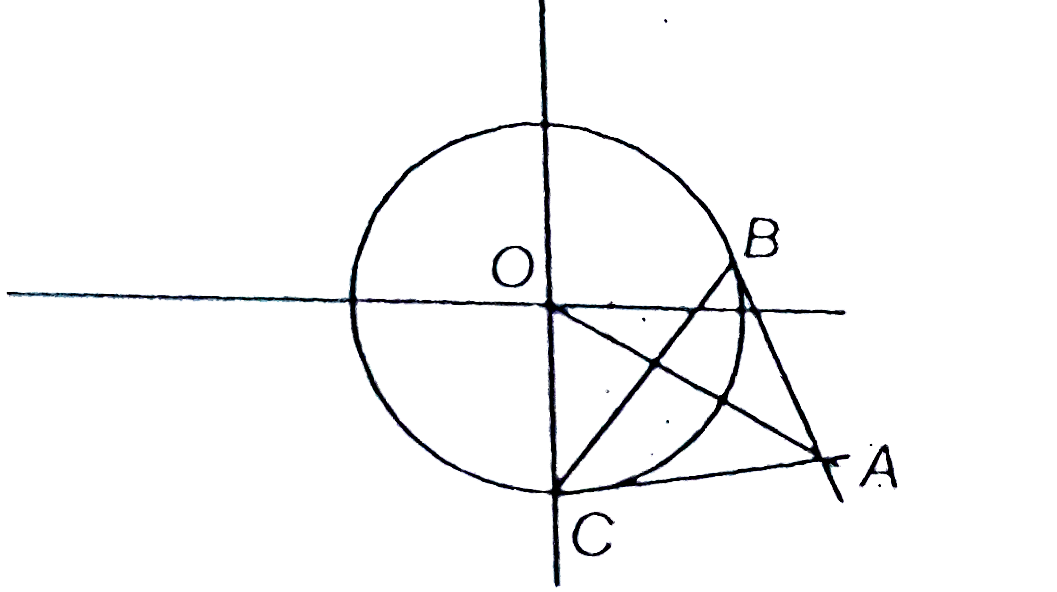Statement I The chord of contact of tangent from three points A, B and C to the circle x2+y2=a2 are concurrent, then A, B and C will be collinear. Statement II A, B and C always lie on the normal to the circle x2+y2=a2.
To solve the given problem, we will analyze both statements one by one.
Step 1: Understanding the Chord of Contact
- The chord of contact of tangents drawn from a point (x1, y1) to the circle x2+y2=a2 is given by the equation:
xx1+yy1=a2
- Similarly, for points B (x2, y2) and C (x3, y3), the equations are:
xx2+yy2=a2
xx3+yy3=a2
Step 2: Condition for Concurrency
- For the three lines (chords of contact) to be concurrent, the determinant formed by the coefficients of the equations must be zero:
∣∣
∣
∣∣x1y1a2x2y2a2x3y3a2∣∣
∣
∣∣=0
- This simplifies to:
x1y2+x2y3+x3y1−(y1x2+y2x3+y3x1)=0
- This condition indicates that the points A, B, and C are collinear.
Step 3: Analyzing Statement I
- Since the condition for concurrency leads to the conclusion that points A, B, and C are collinear, Statement I is correct.
Step 4: Analyzing Statement II
- Statement II claims that points A, B, and C always lie on the normal to the circle.
- However, this is not necessarily true. The normal at a point on the circle is unique to that point, and points A, B, and C can be outside the circle or at arbitrary positions not aligned with the normal.
- Therefore, Statement II is incorrect.
Final Conclusion:
- Statement I is true: The chord of contact from points A, B, and C being concurrent implies that A, B, and C are collinear.
- Statement II is false: A, B, and C do not necessarily lie on the normal to the circle.
- The chord of contact of tangents drawn from a point (x1, y1) to the circle x2+y2=a2 is given by the equation:
xx1+yy1=a2
- Similarly, for points B (x2, y2) and C (x3, y3), the equations are:
xx2+yy2=a2
xx3+yy3=a2
- For the three lines (chords of contact) to be concurrent, the determinant formed by the coefficients of the equations must be zero:
∣∣
∣
∣∣x1y1a2x2y2a2x3y3a2∣∣
∣
∣∣=0
- This simplifies to:
x1y2+x2y3+x3y1−(y1x2+y2x3+y3x1)=0
- This condition indicates that the points A, B, and C are collinear.
- Since the condition for concurrency leads to the conclusion that points A, B, and C are collinear, Statement I is correct.
- Statement II claims that points A, B, and C always lie on the normal to the circle.
- However, this is not necessarily true. The normal at a point on the circle is unique to that point, and points A, B, and C can be outside the circle or at arbitrary positions not aligned with the normal.
- Therefore, Statement II is incorrect.
- Statement I is true: The chord of contact from points A, B, and C being concurrent implies that A, B, and C are collinear.
- Statement II is false: A, B, and C do not necessarily lie on the normal to the circle.
Topper's Solved these Questions
- COMPLEX NUMBERS AND QUADRATIC EQUATIONSBOOK - CENGAGE ENGLISHCHAPTER - COMPLEX NUMBERS AND QUADRATIC EQUATIONSEXERCISE - All Questions
886 Videos
- DIFFERENT PRODUCTS OF VECTORS AND THEIR GEOMETRICAL APPLICATIONS BOOK - CENGAGE ENGLISHCHAPTER - DIFFERENT PRODUCTS OF VECTORS AND THEIR GEOMETRICAL APPLICATIONS EXERCISE - Multiple correct answers type
11 Videos
Similar Questions
The chords of contact of tangents from three points A,BandC to the circle x2+y2=a2 are concurrent. Then A,BandC will be
View SolutionThe chord of contact of tangents from 3 points A, B, C to the circle x2+y2=4 are concurrent, then the points A, B and C are:
View SolutionStatement 1 : If the chords of contact of tangents from three points A,B and C to the circle x2+y2=a2 are concurrent, then A,B and C will be collinear. Statement 2 : Lines (a1x+b1y+c1)+k(a2x+b2y+c2)=0 alwasy pass through a fixed point for k∈R .
View SolutionThe chords of contact of tangents from three points A,BandC to the circle x2+y2=a2 are concurrent. Then A,BandC will (a)be concyclic (b) be collinear (c)form the vertices of a triangle (d)none of these
View SolutionThe length of the chord of contact of the tangents drawn from the point (−2,3) to the circle x2+y2−4x−6y+12=0 is:
View SolutionLet the midpoint of the chord of contact of tangents drawn from A to the circle x2+y2=4 be M(1,−1) and the points of contact be B and C

View SolutionIf the chord of contact of tangents from a point (x1,y1) to the circle x2+y2=a2 touches the circle (x−a)2+y2=a2, then the locus of (x1,y1) is
View SolutionIf the chord of contact of tangents from a point P(h, k) to the circle x2+y2=a2 touches the circle x2+(y−a)2=a2, then locus of P is
View SolutionFind the equation to the chord of contact of the tangents drawn from an external point (−3,2) to the circle x2+y2+2x−3=0.
View SolutionFind the equation to the chord of contact of the tangents drawn from an external point (−3,2) to the circle x2+y2+2x−3=0.
View Solution
